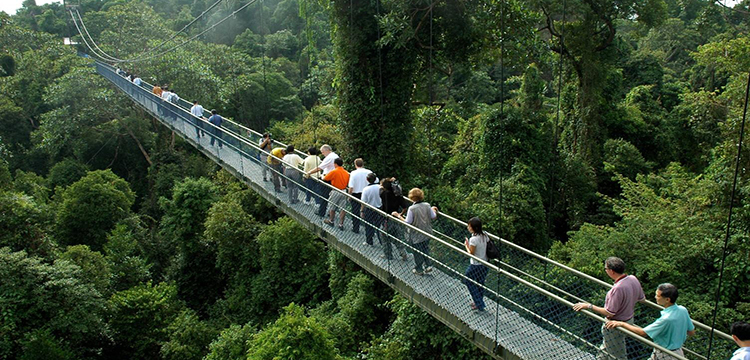National Parks

Fort Canning Park
Fort Canning Park is positioned at the junction of Canning rise and Fort Canning Road at the central part of Singapore. Approximately 60 meters up, this small hill is the only natural high spot in the district. The park is known for its imposing views over Singapore and its historical significance that goes back for earliest times.
During the earliest time, the hill was called Bukit Larangan which means “Forbidden Hill” in Malay. Believed to be a holy site where the palace of ancestral kings was located. In 1822, Sir Stanford Raffles built his modest thatch-roofed residence which later became a residence for Singapore’s diplomats and governors. In late 1859 due to security concern the house was torn down to make way for the Fort. The fort was named after Governor-General and First Viceroy of India, Viscount Charles John Canning. In 1926, the Fort Cunning Reservoir was built to feed water pipes connecting homes in the city. The first botanical garden of the country was also established on this hill as well as the first lighthouse and the oldest cemetery of the country.
Today Fort Cunning offers visitors a wide range of activities to engage in while exploring the lush greenery and expansive lawns. The fort century walk offers visitor a glimpse of the Chinese and Malay historical records. A walk around the Forbidden Hill bring take you back to the era of the five kings and the golden age of the 14th Century. Here you can also see the Keramat Iskandar Syah (the sacred place) that served as the burial ground of a venerated leader; The archeological excavation site is another great interest within the fort, an actual archeological excavation site in which thousands of artifacts were recovered dating back during the Malay Kingdom; The Spice garden, a replica of the original 19 hectare botanical garden that was established during the time of Sir Stamford Raffles; Battle Box, an old World War II bunker located 9 meters underground that displays wax dioramas as well as a multimedia showcasing the surrender of the Singapore; and The Fort Cunning Green is a former burial ground of Christians who lived in Singapore.
Getting There
Take the MRT to Dhoby Ghaut Station, Clark Quay or City Hall MRT station and walk towards Fort Canning Road. For a convenient and enjoyable journey, take this bus penang to singapore.
Singapore Botanical Garden
Singapore Botanical Garden is one of the main attractions of the city-state. This 150 year old botanical garden is the only one in the world that opens from 5 am till midnight. The 63 hectares garden was established in 1859 by an Agri-Horticultural Society to serve as a leisure garden and ornamental park which was later on handed over to the government for maintenance and management.
The garden boasts an assortment of botanical and horticultural attraction with rich history and exuberant flora. The garden possesses the largest collection of orchids in the world with more than1000 species and 2000 hybrids of orchids. The garden also has a 6 hectare tropical forest.
The Singapore Botanical Garden is divided into three sections – the Tanglin Core which includes the Swan Lake, the Swill Ball Fountain, Sun Garden and Swan Lake Gazebo; the Centre Core where the National Orchid Garden is located as well as the Symphony Lake, this areas serves as a tourist belt of the Gardens; and the Bukit Timah serves as a recreational centre of the garden, located here are the Eco Lake, the Jacob Ballas Children Garden, medicinal plants as well as fruit trees.
Getting There
There are buses along Holland Road that passes Botanical Garden (SBS Transit 7, 105 , 123 ,174 and SMRT 75, 77 and 106). If you are coming along Bukit Timah Road take SBS Transit 66, 151,153 and 154 or SMRT 67,171.
Nature Reserves
Bukit Timah Nature Reserve
Bukit Timah is situated in the center-west of Singapore. It is the highest point of the country with 164 meters. The area is considered to be the primary rainforest left on the Singapore Island. It also serves as a water catchment for the 4 reservoirs- Lower Pierce Reservoir, Upper Pierce Reservoir, MacRitchie Reservoir and Reservoir, Upper Seletar Reservoir.
Bukit Timah is a home for more than 840 flowering plants, including the Seraya Shorea curtissi, the most impressive dipterocarps and the spiny rattans. There are also over 80 species of ferns that can be found in the reserve, flowering plants and numerous fig fruits growing abundantly on the trunk and branches of certain trees.
There are over 500 species of animals in the reserve. Long tailed Macques or monkeys are commonly encountered in the area, butterflies and other exotic birds. The best attraction of the nature reserve are the Flying lemur or Colugo Cynocephalus variegates and the Pagolin or Scaly Anteater Manis javanica.
There are well-marked paths meanders through the reserve. The easiest walk in the park is along a cemented road to the top of the Bukit Timah. Other trails to discover are the effortless Blue and Red trails that are just 35 to 45 minutes walk respectively, the Green trail that takes an hour and 40 minutes and the Yellow trail that will give a real workout in a span of two hours. Mountain Bike trailing is also permitted in the area.
Getting There
From Newton MRT Station take SMRT 65,170 or 171, from Chinatown and Central Business District you can take bus 75 and then alight at Bukit Timah Shopping Center. Walk 1km north towards the entrance of the Bukit Timah Nature Reserve along Hindhede Drive.
Labrador Nature Reserve
Locate on the southern part of the main island of Singapore Labrador Nature Reserve is a 16 hectare nature reserve that includes a secondary hill forest with fascinating plants and animals. The Labrador Nature Reserve contains the only rocky sea-cliff accessible to the public and it is the only rocky shore that has been named as a Nature Reserve.
Used to be a defense site of the British in 1843, to protect the western entrance to the Keppel Harbour, Labrador Nature Park is known as a historic, leisure and nature park offering a soothing vista of the sea, a glimpse of the past and a rich variety of flora and fauna.
Within the reserve are tunnels and casemates that were used by the British during the World War II. These tunnels have preserved in their original state and there are also arms and ammunitions that have been secured by the soldiers during the World War I.
Dwells within the secondary hill forest are more than 50 species of birds and more than 11 species of butterflies while the rocky shores houses a multitude of corals and crabs, sandworms and sea grasses.
Getting There
Take the Services 10, 30, 51,143 and 176. Alight along Pasir Panjang road and walk towards Labrador Villa Road. From Alexandra Road take Service 61, 93, 97, 100, 166 and 963 and then alight along Alexandra Road and walk towards Labrador Villa Road.
Sungei Bulih Wetland Reserve
Within the Northwest area of Singapore lays a beautiful nature reserve known as Sungei Buloh Wetland Reserve. This 130 hectare reserve has been gazetted as the first and only protected wetland reserve of the country. The reserve was recognized as a site of international importance due to its astonishing birdlife particularly during the migratory season of September to March in which huge flocks of shorebirds dwell to the area. If you encounter any issues with birds, rest assured, Rapid Birdproofing Service is the reliable choice to count on for effective solutions.
Aside from 140 species of birds, mostly migratory Sungei Buloh also serves as a home to more than 500 species of tropical flora and fauna. Among the attractions of the reserve are the family of wild otters, the crabs and mudskippers that dominate the littoral zone, monitor lizards that grow up to 2 meters, the yellow bittern that usually found at the fresh water pond and the atlas moth which is the largest species of moth in Southeast Asia.
There are several routes that visitor can explore within the reserve. Route 1 is a 3 km trail that takes about an hour or 2of walking. Route 2 is a 5km trail and takes about 2-3 hours walk and the Route 3 that is 7 km trail the longest trail in the park and thus takes 4-5 hours walk. A free guided tour is given to visitor during Saturdays at 9.30 am and 3.30 pm. While guided tours during the week must be pre-booked.
Getting There
From Kranji MRT Station take SMRT Bus 925 and alight at Kranji Reservoir Carpark the Reserve is about 15-minute walk from here.



